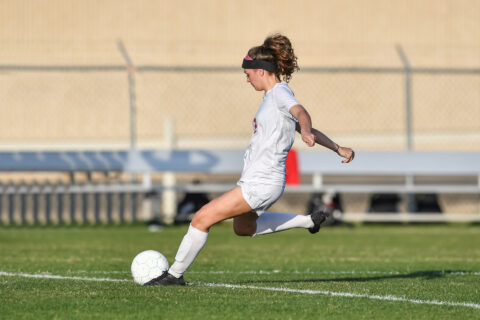Investigating injuries to the anterior cruciate ligament
Analytical system FAME measures the probability of ACL injuries
It is a very common complaint among soccer players– an injury to the anterior cruciate ligament (ACL) is not only painful, it can lead to several weeks if not months of imposed rest, depending on the severity of the injury. There are special training programs for protecting the front cruciate ligament that have proven to be effective in scientific studies. However, they are not being used enough. The reason: Researchers and coaches do not yet understand why the exercises work as well as they do.
A team of researchers led by Prof. Dr. Anne Koelewijn from FAU together with Universität Innsbruck is now using the analysis system FAME to investigate this question.
It is well known that the front cruciate ligament is susceptible to tearing in sport. Existing training units therefore focus on protecting it and preventing injuries. Whilst investigations have already shown that these exercises can protect the cruciate ligament, it is as yet unknown why they are so effective. This is what the research project “Bridging the gap in ACL injury prevention with FAME: Field-based Athlete Motion Evaluation and simulation” hopes to change.
“There is a maximum limit of strain the ACL can take,” explains Prof. Dr. Anne Koelewijn, who is the lead investigator for FAME at FAU, and in charge of the Computational Movement Science group. “As soon as this limit is exceeded, the cruciate ligament tears and injury occurs. We don’t know what exactly this limit is, and it probably varies from person to person. Examining the training programs will show us whether they can lead to reduced strain and whether this will lead in turn to a reduced risk of injury.”
Answering the question of the effectiveness of the training programs would lead to a more precise definition of which exercises are most suitable for which types of sport.
FAME in soccer
FAME is unfortunately too late for this year’s world cup in women’s soccer: roughly 25 to 30 players were unable to take part thanks to knee injuries. Two of them are from the German team. The findings from the next three years may be helpful for the next championship, however.
The teams led by Prof. Anne Koelewijn and Prof. Maurice Mohr from Universität Innsbruck are therefore now looking at the stated training methods in greater detail. Mobile analysis devices are used to analyze athletes’ movements in order to determine how much strain the body as a whole, including the front cruciate ligament, is under.
For eight weeks, soccer players from Austrian teams will wear eight sensors on their feet, legs and back during training sessions and matches. The researchers hope to find out what effect the training program has on movement strategies when changing direction in actual match situations. A control group will not carry out the exercises designed to strengthen the cruciate ligament.
The data they gather will also allow Prof. Koelewijn and her colleagues to simulate movements with virtual athletes and check which training protects the front cruciate ligament best under which conditions. At a later stage, they hope to reduce number of sensors to three, attached to the feet and the back. A prerequisite before reducing the number of sensors is that data remain accurate, however.
Fewer torn ligaments in future?
FAME is the first study that will allow scientists to estimate the force exerted on the cruciate ligament during genuine sporting activities. “By gaining a better understanding of the way training programs work to prevent injuries to the cruciate ligament, we hope that fewer people will be affected in future,” explains Prof. Koelewijn. “Based on our results, we would like to give recommendations for designing even more effective training programs in future.”
The FAME project will be funded from October 2023 up until and including September 2026 by the Austrian Science Fund (FWF). Funding amounting to approximately 227,000 euros will benefit Prof. Mohr’s work, who is focusing with his team on the impact of training programs on the strain exerted on the front cruciate ligament.
The German Research Foundation (DFG) will start providing funding as of January 2024, and it will run until the end of 2026. Approximately 276,300 euros will be made available to Prof. Koelewijn’s research group to develop the technical side of the analysis system.
Further information
Prof. Anne Koelewijn
Professorship of Computational Movement Science
anne.koelewijn@fau.de
